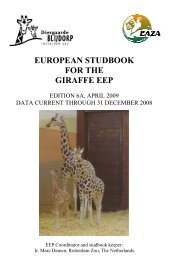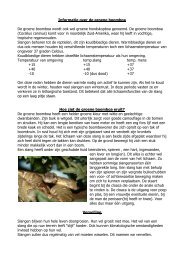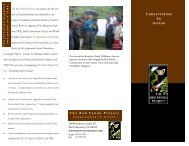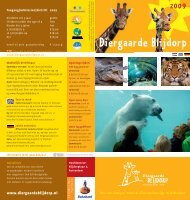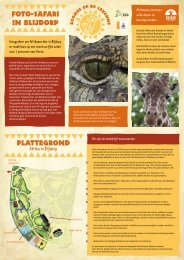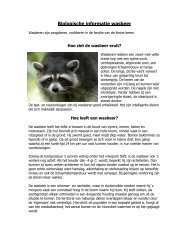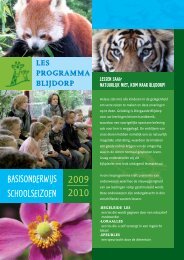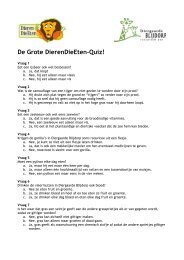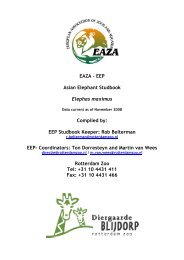Create successful ePaper yourself
Turn your PDF publications into a flip-book with our unique Google optimized e-Paper software.
<strong>EEP</strong> STUDBOOK CROWNED PIGEONS<br />
In some cases the keepers were too cooperative. If a researcher is studying one species for<br />
over six months, the keepers get eager and start looking more intensive to this enclosure.<br />
From one day to the other, they notice things and suddenly they start changing things.<br />
Furthermore Duncan’s Multiple Range Test sometimes showed more significant differences<br />
than the PROC GLM. This can be explained by the fact that PROC GLM is less precise than<br />
Duncan’s Multiple Range Test. This can be seen clearly at the behavioural categories positive<br />
and negative social behaviour. PROC GLM regularly states that the differences are<br />
significant, but the <strong>number</strong>s are very low and not comparable with the <strong>number</strong> in the other<br />
categories.<br />
Although this research project lasted six months, it is difficult to draw general conclusions.<br />
One of the major insights is that crowned <strong>pigeon</strong>s are very susceptible to changes in their<br />
environment. In one case it lasted for over six weeks before the birds dared to use a new<br />
perch. Before the project started this was not taken into account. Because of the short time of<br />
the research project, the birds not always got enough time to get used to the changes in their<br />
environment.<br />
Discussion about the results<br />
Observational research project<br />
Males versus females<br />
No significant differences could be found in time budgets between males and females. This is<br />
not very strange because it turned out that the differences between the enclosures are very<br />
large. The males seem to be slightly more active than the females, because they show less<br />
behaviour in time and more behaviour in space.<br />
Differences between enclosures<br />
Large differences between the enclosures were found, and a lot, but not all of these<br />
differences can be explained by differences in husbandry. For example the crowned <strong>pigeon</strong>s<br />
in Rotterdam Zoo showed significantly more behaviour in time than the other pairs. This<br />
might be explainable by the low temperature of this enclosure. Two pairs significantly<br />
showed more positive social behaviour and more reproductive behaviour but these birds were<br />
respectively starting to build a nest and hatching an egg.<br />
The crowned <strong>pigeon</strong>s in Burgers’ Bush showed significantly more negative social behaviour,<br />
which can be explained by the fact that in this enclosure there were two pairs of crowned<br />
<strong>pigeon</strong>s. The birds in the Bush showed less “care”-behaviour than the other pairs. This might<br />
mean that preening is an expressing of being bored. Burgers’ Bush is more spacious and<br />
offers the birds much more possibilities to conduct natural behaviour than the other<br />
enclosures.<br />
The birds in Rotterdam Zoo showed more metabolic behaviour, which might be explained by<br />
the size and furnishing of this enclosure, which offers the crowned <strong>pigeon</strong>s almost no<br />
possibilities to conduct natural behaviour.<br />
109



